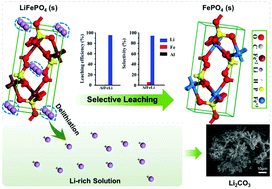当前位置:
X-MOL 学术
›
Green Chem.
›
论文详情
Our official English website, www.x-mol.net, welcomes your
feedback! (Note: you will need to create a separate account there.)
Selective recovery of lithium from spent lithium iron phosphate batteries: a sustainable process
Green Chemistry ( IF 9.3 ) Pub Date : 2018-06-05 , DOI: 10.1039/c7gc03376a Yongxia Yang 1, 2, 3, 4, 5 , Xiangqi Meng 5, 6, 7, 8, 9 , Hongbin Cao 5, 6, 7, 8, 9 , Xiao Lin 5, 6, 7, 8, 9 , Chenming Liu 5, 6, 7, 8, 9 , Yong Sun 10, 11, 12 , Yi Zhang 1, 2, 3, 4, 5 , Zhi Sun 5, 6, 7, 8, 9
Green Chemistry ( IF 9.3 ) Pub Date : 2018-06-05 , DOI: 10.1039/c7gc03376a Yongxia Yang 1, 2, 3, 4, 5 , Xiangqi Meng 5, 6, 7, 8, 9 , Hongbin Cao 5, 6, 7, 8, 9 , Xiao Lin 5, 6, 7, 8, 9 , Chenming Liu 5, 6, 7, 8, 9 , Yong Sun 10, 11, 12 , Yi Zhang 1, 2, 3, 4, 5 , Zhi Sun 5, 6, 7, 8, 9
Affiliation

|
In recent years, the recovery of metals from spent lithium ion batteries (LIBs) has become increasingly important due to their great environmental impact and the wastage of valuable metallic resources. Among different types of spent LIBs, processing and recycling the spent LiFePO4 batteries are challenging because of their relatively low extraction efficiency and recycling selectivity of valuable metal(s) and great potential for secondary waste generation. In this research, an effective and sustainable approach for selective leaching of lithium from spent LiFePO4 batteries was demonstrated. By properly adjusting or controlling the oxidative state and proton activity of the leaching solution, lithium was found to be selectively leached with a high recovery efficiency. The aluminium remained in the metallic form and iron as FePO4 in the solid residue which can be easily separated by sieving. The effects of a range of parameters (i.e. acid concentration, initial volume fraction of the oxidant, liquid-to-solid ratio, reaction temperature and time) during lithium leaching were comprehensively investigated. The selective reaction mechanisms were clarified and the controlling step for the leaching kinetics was identified. Based on the laboratory scale results, a pilot batch process was developed and simulated. The process is found to be techno-economically feasible and environmentally friendly for recycling of spent LiFePO4 batteries using selective leaching. High purity Li2CO3 (99.95 wt%) could be obtained with a high recovery rate. This research demonstrates the possibility of improving the metal recycling effectiveness from spent LiFePO4 batteries by incorporating the principles of green chemistry and probably contributes to the sustainability of the lithium ion battery industry.
中文翻译:

从废磷酸铁锂电池中选择性回收锂:可持续过程
近年来,由于废旧锂离子电池(LIB)的巨大环境影响和宝贵金属资源的浪费,从废旧锂离子电池(LIB)中回收金属已变得越来越重要。在不同类型的废LIB中,处理和回收用过的LiFePO 4电池具有挑战性,因为它们的提取效率相对较低,并且贵金属的回收选择性较低,并且具有产生二次废物的巨大潜力。在这项研究中,一种有效且可持续的方法可以从用过的LiFePO 4中选择性浸出锂电池进行了演示。通过适当地调节或控制浸出溶液的氧化态和质子活性,发现锂以高回收率被选择性地浸出。铝以金属形式保留,铁以FePO 4形式保留在固体残留物中,可以通过筛分将其轻松分离。一系列参数的影响(即综合研究了锂的浸出过程中的酸浓度,氧化剂的初始体积分数,液固比,反应温度和时间。阐明了选择性反应机理,并确定了浸出动力学的控制步骤。基于实验室规模的结果,开发并模拟了中试过程。发现该方法对于使用选择性浸出回收用过的LiFePO 4电池是技术上经济可行的,并且对环境友好。可以高回收率获得高纯度的Li 2 CO 3(99.95 wt%)。这项研究表明,用过的LiFePO 4可以提高金属的回收利用效率。 电池通过结合绿色化学原理,可能有助于锂离子电池行业的可持续发展。
更新日期:2018-07-02
中文翻译:

从废磷酸铁锂电池中选择性回收锂:可持续过程
近年来,由于废旧锂离子电池(LIB)的巨大环境影响和宝贵金属资源的浪费,从废旧锂离子电池(LIB)中回收金属已变得越来越重要。在不同类型的废LIB中,处理和回收用过的LiFePO 4电池具有挑战性,因为它们的提取效率相对较低,并且贵金属的回收选择性较低,并且具有产生二次废物的巨大潜力。在这项研究中,一种有效且可持续的方法可以从用过的LiFePO 4中选择性浸出锂电池进行了演示。通过适当地调节或控制浸出溶液的氧化态和质子活性,发现锂以高回收率被选择性地浸出。铝以金属形式保留,铁以FePO 4形式保留在固体残留物中,可以通过筛分将其轻松分离。一系列参数的影响(即综合研究了锂的浸出过程中的酸浓度,氧化剂的初始体积分数,液固比,反应温度和时间。阐明了选择性反应机理,并确定了浸出动力学的控制步骤。基于实验室规模的结果,开发并模拟了中试过程。发现该方法对于使用选择性浸出回收用过的LiFePO 4电池是技术上经济可行的,并且对环境友好。可以高回收率获得高纯度的Li 2 CO 3(99.95 wt%)。这项研究表明,用过的LiFePO 4可以提高金属的回收利用效率。 电池通过结合绿色化学原理,可能有助于锂离子电池行业的可持续发展。











































 京公网安备 11010802027423号
京公网安备 11010802027423号